The Church
Most churches of any age at all have aspects that can be attributed to the different generations that built the church and worshipped in it over the years. A baptismal font will be dated from a specific time, for example, or a memorial altar might clearly date from the years following WWII. The Abbey Church of Marmoutier is no exception, and in its structure, you can quite clearly see the contributions not only of different years, but of different centuries and style periods in the history of the church in Europe. The church itself is built of a reddish local sandstone, not unlike many other buildings in this part of Alsace. This building, however, contains elements of Romanesque, Gothic, eighteenth- and nineteenth-century styles in layers that are clearly separated and distinct from one another.
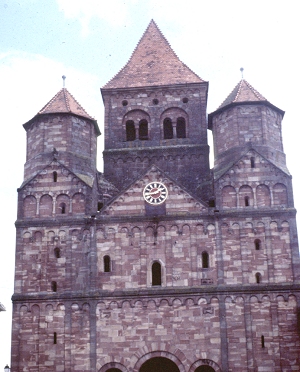 As you can see in the photograph to the right, the West façade is almost stereotypically Romanesque. It is fortress-like in its solidity, with the rounded arches arranged in horizontal bands and small windows that give almost no relief to the appearance of solid stone. The central bell-tower and its two octagonal companions even have a heavy, almost squat, appearance. The promise of a Romanesque church is not fulfilled in the rest of the building, however, for what is seen here - - the Porch and narthex, with the towers above - - is all that remains of the Romanesque building that was begun in the eleventh century. As you can see in the photograph to the right, the West façade is almost stereotypically Romanesque. It is fortress-like in its solidity, with the rounded arches arranged in horizontal bands and small windows that give almost no relief to the appearance of solid stone. The central bell-tower and its two octagonal companions even have a heavy, almost squat, appearance. The promise of a Romanesque church is not fulfilled in the rest of the building, however, for what is seen here - - the Porch and narthex, with the towers above - - is all that remains of the Romanesque building that was begun in the eleventh century.
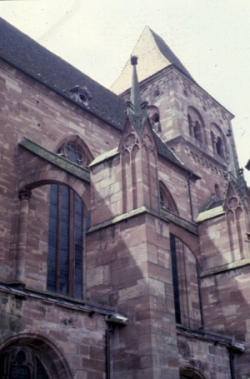 If you walk around the church to the left (the north) and look up and back toward the West end, you can see that there is an enormous contrast in architectural styles, even though the same stone was used for the nave. The nave was begun over a century after the narthex and the West façade, and as you can see in the the second photograph, its Gothic style makes the original towers of the older part of the church look almost anachronistic in comparison. The nave was actually built in the third quarter of the thirteenth century, and, as in all examples of Gothic architecture, those flying buttresses indicate the possibility of more wall space devoted to windows. Those windows show the typical Gothic pointed arch shape that leads the eye upward and makes the solid rounded arches of the older part of the building look earth-bound by comparison. The decorative spires that sit atop the column of each flying buttress are slender and graceful, and as you see in the photograph, they also make the Romanesque roofs of the towers look like they belong on the ground, not in the air. If you walk around the church to the left (the north) and look up and back toward the West end, you can see that there is an enormous contrast in architectural styles, even though the same stone was used for the nave. The nave was begun over a century after the narthex and the West façade, and as you can see in the the second photograph, its Gothic style makes the original towers of the older part of the church look almost anachronistic in comparison. The nave was actually built in the third quarter of the thirteenth century, and, as in all examples of Gothic architecture, those flying buttresses indicate the possibility of more wall space devoted to windows. Those windows show the typical Gothic pointed arch shape that leads the eye upward and makes the solid rounded arches of the older part of the building look earth-bound by comparison. The decorative spires that sit atop the column of each flying buttress are slender and graceful, and as you see in the photograph, they also make the Romanesque roofs of the towers look like they belong on the ground, not in the air.
 After the building of the thirteenth century was completed, the convent of Marmoutier fell upon hard times and its resources were depleted. Much of its property and even the windows and altar of the church were destroyed in the first half of the sixteenth century in uprisings that were part of the Peasants' Revolt that occupied much of central and southern Germany. Then, in the eighteenth century, the church entered a new phase of restoration that resulted in the commissioning of a new choir, with its main altar, and the organ. The church survived the French revolution and the dissolution of the monasteries and convents, and in 1805 Marmoutier was made a parish church. The present windows, one of which is shown to the right, were installed beginning in the nineteenth century. In their use of brilliant colors they continue the tradition of lighting the interior of the church that was established as a part of the Gothic style. After the building of the thirteenth century was completed, the convent of Marmoutier fell upon hard times and its resources were depleted. Much of its property and even the windows and altar of the church were destroyed in the first half of the sixteenth century in uprisings that were part of the Peasants' Revolt that occupied much of central and southern Germany. Then, in the eighteenth century, the church entered a new phase of restoration that resulted in the commissioning of a new choir, with its main altar, and the organ. The church survived the French revolution and the dissolution of the monasteries and convents, and in 1805 Marmoutier was made a parish church. The present windows, one of which is shown to the right, were installed beginning in the nineteenth century. In their use of brilliant colors they continue the tradition of lighting the interior of the church that was established as a part of the Gothic style.
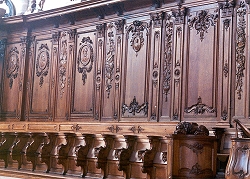 The present choir, including all the carved wookwork of the stalls and the altar, dates from the middle of the eighteenth century. The carvings are rich in detailed vines, leaves and other Rococo figures, and they are among the best examples of the style in Alsace. The present choir, including all the carved wookwork of the stalls and the altar, dates from the middle of the eighteenth century. The carvings are rich in detailed vines, leaves and other Rococo figures, and they are among the best examples of the style in Alsace.
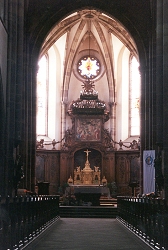 The focal point of the choir is, of course, the main altar, which is placed beneath the only surviving original stained glass window. The retable is of gilded wood, richly carved, and on it rest the tabernacle, flanked by two symbols of Christ: The Good Shepherd and The Pelican feeding its young from her breast. On either side of the altar are the reliquaries of Saints Céleste and Auteur. Above the table is a painting of the Nativity; the original, attributed to Rubens, disappeared in 1794. Carved vines, leaves, flowers and figures of angels and musicians surround the painting. If you pass your mouse pointer over the photograph to the right, you can get a closer look. The focal point of the choir is, of course, the main altar, which is placed beneath the only surviving original stained glass window. The retable is of gilded wood, richly carved, and on it rest the tabernacle, flanked by two symbols of Christ: The Good Shepherd and The Pelican feeding its young from her breast. On either side of the altar are the reliquaries of Saints Céleste and Auteur. Above the table is a painting of the Nativity; the original, attributed to Rubens, disappeared in 1794. Carved vines, leaves, flowers and figures of angels and musicians surround the painting. If you pass your mouse pointer over the photograph to the right, you can get a closer look.
The Organ
In 1710 Andreas Silbermann (1678-1734) built a new organ for the Abbey Church at Marmoutier. Earlier Andreas and Gottfried, his brother, had worked together, but Gottfried had not long before left Strasbourg for Saxony, in order to set up his own organ- building concern there. In fact, both Andreas and Gottfried had traveled a bit, and Andreas himself had worked in Paris with Alexandre Thierry from 1704-1706. While he was there, Andreas absorbed the fundamental elements of Parisian - - therefore French Classical - - organ building. The Marmoutier organ, like his other instruments, has the technical construction and pipe scaling of a classical French organ. On the other hand, the voicing gives the instrument a German accent: the Plein jeu is stronger, and the stopped flutes have more color in their sustained tone.
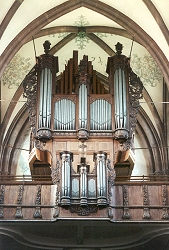 In its overall design, the case appears to be that of a typical French Classical organ. When you look at it, In its overall design, the case appears to be that of a typical French Classical organ. When you look at it,
- you see only two divisions (Grand Orgue and Positif).
- you don't see any sign in the façade of the Pedal and/or Récit divisions.
- you see all pipe feet standing at the impost level.
- you see rounded towers,
- and the taller towers of both cases are at the extremes, not in the middle.
When the organ was built, it consisted of only two manual divisions (Hauptwerk and Rückpositiv) and a single stop in the pedal: a 16' Subbass. In 1746, the organ was enlarged by Johann Andreas Silbermann - - Andreas' son, who was continuing the family business of organ-building in Alsace. He added
- a Récit division, which is located in the usual Echo position in the case,
- four new stops to the Pedal,
- and a Cromhorne to the Positiv.
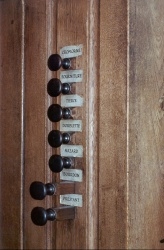 When you first go to the keydesk, you might be surprised to find that the stopknobs for the Positiv division are behind you, in the Positiv case itself. This is not an unusual arrangement on Andreas' instruments. If you pass your mouse pointer over the photograph on the left, you will see a detailed photograph of the first three stop knobs. I know you've already noticed that the pitch designations are not included. I want you to look more closely at them, though, because they are in order as the pipes stand on the chest. The Prestant, whose pipes are in the façade of the Positiv, is first, followed by the 8' Bourdon and the Nazard. The sequence continues upward through the Doublette, the Tierce and the Fourniture, with the Cromorne -- whose pipes are closest to the player on the bench -- at the top of the row. You should notice the difference between this arrangement and the one you are familiar with as the "standard" arrangement of listing stops strictly in pitch order. This example illustrates in part the origin of the standard -- taller pipes are usually placed at the front of the case, shorter ones at the back. In this instance, however, even though the pipes of the first two stops are of almost identical length (the bourdon being composed of stopped pipes), the Prestant comes first because those are the pipes that should be visible. When you first go to the keydesk, you might be surprised to find that the stopknobs for the Positiv division are behind you, in the Positiv case itself. This is not an unusual arrangement on Andreas' instruments. If you pass your mouse pointer over the photograph on the left, you will see a detailed photograph of the first three stop knobs. I know you've already noticed that the pitch designations are not included. I want you to look more closely at them, though, because they are in order as the pipes stand on the chest. The Prestant, whose pipes are in the façade of the Positiv, is first, followed by the 8' Bourdon and the Nazard. The sequence continues upward through the Doublette, the Tierce and the Fourniture, with the Cromorne -- whose pipes are closest to the player on the bench -- at the top of the row. You should notice the difference between this arrangement and the one you are familiar with as the "standard" arrangement of listing stops strictly in pitch order. This example illustrates in part the origin of the standard -- taller pipes are usually placed at the front of the case, shorter ones at the back. In this instance, however, even though the pipes of the first two stops are of almost identical length (the bourdon being composed of stopped pipes), the Prestant comes first because those are the pipes that should be visible.
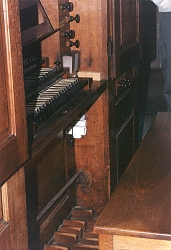 In 1915 the pedalboard was replaced with the usual German type: a flat, straight pedalboard, having the long keys associated with German, British and American organs. Of course, no machine can last for more than 200 years without some mechanical problems developing, and the organ at Marmoutier is no exception. After WWII it was in need of heavy maintenance and repair work, and in 1955 the organ was restored by Ernst Mühleisen and Alfred Kern of Strasbourg, working under the supervision of Albert Schweitzer. They made only two changes to the instrument: In 1915 the pedalboard was replaced with the usual German type: a flat, straight pedalboard, having the long keys associated with German, British and American organs. Of course, no machine can last for more than 200 years without some mechanical problems developing, and the organ at Marmoutier is no exception. After WWII it was in need of heavy maintenance and repair work, and in 1955 the organ was restored by Ernst Mühleisen and Alfred Kern of Strasbourg, working under the supervision of Albert Schweitzer. They made only two changes to the instrument:
- They added two notes to the pedal, giving it a compass of C-d' in order to play more works of Bach.
- They made a stop action for the pedal flutes.
With the exception of this work in the twentieth century, the organ remains as it was after the completion of Johan Andreas' additions in 1746. The chests, manual keyboards, action and pipes are all original. The work done by Mühleisen and Kern is still regarded as a model of restoration, and, along with the organ at Ebersmunster, the Marmoutier organ is one of the two most well-preserved Silbermann organs today.
Stoplist
It is part of the history of Alsace that names of stops and divisions of this instrument show a mixture of German and French, just as the sounds themselves are a blend of the two organ-building traditions.
|

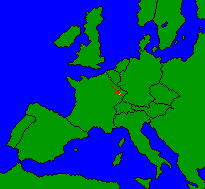
 As you can see in the photograph to the right, the West façade is almost stereotypically Romanesque. It is fortress-like in its solidity, with the rounded arches arranged in horizontal bands and small windows that give almost no relief to the appearance of solid stone. The central bell-tower and its two octagonal companions even have a heavy, almost squat, appearance. The promise of a Romanesque church is not fulfilled in the rest of the building, however, for what is seen here - - the Porch and narthex, with the towers above - - is all that remains of the Romanesque building that was begun in the eleventh century.
As you can see in the photograph to the right, the West façade is almost stereotypically Romanesque. It is fortress-like in its solidity, with the rounded arches arranged in horizontal bands and small windows that give almost no relief to the appearance of solid stone. The central bell-tower and its two octagonal companions even have a heavy, almost squat, appearance. The promise of a Romanesque church is not fulfilled in the rest of the building, however, for what is seen here - - the Porch and narthex, with the towers above - - is all that remains of the Romanesque building that was begun in the eleventh century. If you walk around the church to the left (the north) and look up and back toward the West end, you can see that there is an enormous contrast in architectural styles, even though the same stone was used for the nave. The nave was begun over a century after the narthex and the West façade, and as you can see in the the second photograph, its Gothic style makes the original towers of the older part of the church look almost anachronistic in comparison. The nave was actually built in the third quarter of the thirteenth century, and, as in all examples of Gothic architecture, those flying buttresses indicate the possibility of more wall space devoted to windows. Those windows show the typical Gothic pointed arch shape that leads the eye upward and makes the solid rounded arches of the older part of the building look earth-bound by comparison. The decorative spires that sit atop the column of each flying buttress are slender and graceful, and as you see in the photograph, they also make the Romanesque roofs of the towers look like they belong on the ground, not in the air.
If you walk around the church to the left (the north) and look up and back toward the West end, you can see that there is an enormous contrast in architectural styles, even though the same stone was used for the nave. The nave was begun over a century after the narthex and the West façade, and as you can see in the the second photograph, its Gothic style makes the original towers of the older part of the church look almost anachronistic in comparison. The nave was actually built in the third quarter of the thirteenth century, and, as in all examples of Gothic architecture, those flying buttresses indicate the possibility of more wall space devoted to windows. Those windows show the typical Gothic pointed arch shape that leads the eye upward and makes the solid rounded arches of the older part of the building look earth-bound by comparison. The decorative spires that sit atop the column of each flying buttress are slender and graceful, and as you see in the photograph, they also make the Romanesque roofs of the towers look like they belong on the ground, not in the air. After the building of the thirteenth century was completed, the convent of Marmoutier fell upon hard times and its resources were depleted. Much of its property and even the windows and altar of the church were destroyed in the first half of the sixteenth century in uprisings that were part of the Peasants' Revolt that occupied much of central and southern Germany. Then, in the eighteenth century, the church entered a new phase of restoration that resulted in the commissioning of a new choir, with its main altar, and the organ. The church survived the French revolution and the dissolution of the monasteries and convents, and in 1805 Marmoutier was made a parish church. The present windows, one of which is shown to the right, were installed beginning in the nineteenth century. In their use of brilliant colors they continue the tradition of lighting the interior of the church that was established as a part of the Gothic style.
After the building of the thirteenth century was completed, the convent of Marmoutier fell upon hard times and its resources were depleted. Much of its property and even the windows and altar of the church were destroyed in the first half of the sixteenth century in uprisings that were part of the Peasants' Revolt that occupied much of central and southern Germany. Then, in the eighteenth century, the church entered a new phase of restoration that resulted in the commissioning of a new choir, with its main altar, and the organ. The church survived the French revolution and the dissolution of the monasteries and convents, and in 1805 Marmoutier was made a parish church. The present windows, one of which is shown to the right, were installed beginning in the nineteenth century. In their use of brilliant colors they continue the tradition of lighting the interior of the church that was established as a part of the Gothic style. The present choir, including all the carved wookwork of the stalls and the altar, dates from the middle of the eighteenth century. The carvings are rich in detailed vines, leaves and other Rococo figures, and they are among the best examples of the style in Alsace.
The present choir, including all the carved wookwork of the stalls and the altar, dates from the middle of the eighteenth century. The carvings are rich in detailed vines, leaves and other Rococo figures, and they are among the best examples of the style in Alsace.
 In its overall design, the case appears to be that of a typical French Classical organ. When you look at it,
In its overall design, the case appears to be that of a typical French Classical organ. When you look at it,
 In 1915 the pedalboard was replaced with the usual German type: a flat, straight pedalboard, having the long keys associated with German, British and American organs. Of course, no machine can last for more than 200 years without some mechanical problems developing, and the organ at Marmoutier is no exception. After WWII it was in need of heavy maintenance and repair work, and in 1955 the organ was restored by Ernst Mühleisen and Alfred Kern of Strasbourg, working under the supervision of Albert Schweitzer. They made only two changes to the instrument:
In 1915 the pedalboard was replaced with the usual German type: a flat, straight pedalboard, having the long keys associated with German, British and American organs. Of course, no machine can last for more than 200 years without some mechanical problems developing, and the organ at Marmoutier is no exception. After WWII it was in need of heavy maintenance and repair work, and in 1955 the organ was restored by Ernst Mühleisen and Alfred Kern of Strasbourg, working under the supervision of Albert Schweitzer. They made only two changes to the instrument: